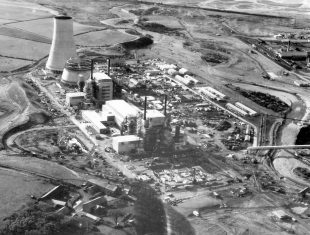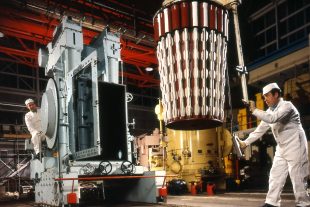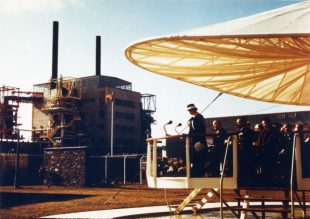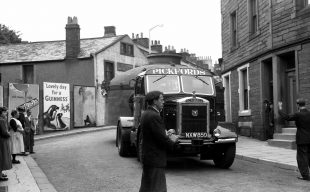Sellafield’s mission is changing. As reprocessing operations end on site, our focus shifts to environmental clean-up and waste management.
As we prepare to take final fuel out of the world’s first commercial nuclear power station, we report on the current clean-up progress being made on the Sellafield site.
What is Calder Hall?
Calder Hall was the first industrial-scale nuclear power station in the world to be connected to the national grid. It consisted of 4 Magnox reactors, 2 turbine halls – and 4 cooling towers, which were demolished in September 2007.

What is Magnox?
Magnox is a type of nuclear power/production reactor that was designed to run on natural uranium with graphite as the moderator and carbon dioxide gas as the heat exchange coolant. It belongs to the wider class of gas-cooled reactors.

How the Calder Hall power station worked
Power stations make electricity. Different stations, whether they’re coal, oil, gas or nuclear (uranium) power stations, all use the same processes to produce electricity. The only difference between coal, oil, gas and nuclear power stations is how the water is heated.
Calder Hall nuclear power station had four reactors, inside which a nuclear reaction took place. The heat generated by this reaction was used to turn water into steam. The steam was then transferred via insulated pipes into one of Calder Hall’s two turbine halls. Here the steam was used to turn a turbine, which drove a generator to produce electricity.
Fact file
- Calder Hall station was opened by Her Majesty the Queen on 17 October 1956

- Workington was the first town in the UK to receive its electricity from nuclear power produced at Calder Hall
- A further 22 Magnox reactors were built in the UK at 10 sites – including an exact replica at Chapelcross
- Two Magnox reactor sites were built overseas at Tokaimura, Japan and in Latina, Italy
- Calder Hall had an original design life of 20 years, but the facility operated safely for 47 years before it closed down on 31 March 2003
- Calder Hall produced enough electricity in its lifetime to power a 3-bar radiator for 2.85 million years – or to meet the average electricity demand of England and Wales for 3 months
- The station covers 43 ¾ acres of the Sellafield site – the same-sized footprint as Buckingham Palace and its grounds
- The size of the station’s heat exchangers was limited by the Ehen Bridge in Egremont, West Cumbria

- Calder Hall’s title of the world’s first nuclear power station was almost lost to the Russians. They started providing electricity to their national grid from a nuclear power station soon after Calder Hall opened
- The wooden hut that stands opposite the station today was set up as a training school for the operators at the new international stations. This makes Calder Hall one of the world's earliest international training schools
- The design and construction of Calder Hall were overseen by Lord Christopher Hinton, a nuclear pioneer and one of the 20th century’s most eminent engineers
- The site where two of Calder Hall’s four cooling towers stood until 2007 is now home to a new Silos Maintenance Facility
The global impact of Calder Hall
Calder Hall was the catalyst for the national and international nuclear relationships that endure today.
The design of Calder Hall was sold to both Italy and Japan. Both countries needed fuel to commission and operate their new stations, so a commercial vehicle was set up to provide the means to sell and transport the fuel.
David Moore, local resident, councillor and chair of the West Cumbria Sites Stakeholder Group said:
Calder Hall? It is like the father of the nuclear industry.
This commercial vehicle was the forerunner to the Nuclear Decommissioning Authority’s International Nuclear Services organisation – with its specialist fleet of transport ships, operated by Pacific Nuclear Transport Ltd.
The decommissioning of Calder Hall
2003
Calder Hall closed down on 31 March 2003, after 47 years of service. On its closure, all 4 of the station’s reactors were full of fuel that would need to be treated in our Magnox reprocessing plant.
2008
In 2008, following the safe demolition of 2 of the station’s cooling towers, parts of the physical structure of the station were removed.

This process started with the removal of pipework that connected the heat exchangers to the four reactors. Each duct that was removed weighed 45 tonnes, and we commissioned one of the world’s biggest cranes to help dismantle the structures.
The external supporting steelwork and stairwells on each of the 16 heat exchangers were also dismantled. The steelwork around each weighed approximately 340 tonnes and, wherever possible, the material was recycled.
2010
We stripped the material from Calder’s heat exchangers, turbine halls and associated buildings.
In all, 2,300 tonnes of asbestos were removed in 5 years - making it the largest asbestos removal project in Europe at the time.
2011
The work to transfer 40,000 fuel rods from the station’s 4 reactors to the Fuel Handling Plant began.
2016
One of Calder Hall’s reactors was emptied of fuel, and we reported that the remaining 3 reactors were on track to be emptied by 2019.

2019
We are preparing to take final fuel out of the world’s first commercial nuclear power station, after 47 years of operation.
Once Calder Hall's reactors are empty – and the initial post-operational clean out work has been completed – the world's first commercial nuclear power station will not pose a nuclear or radiological risk or hazard.
The Calder Hall site will then enter a period of interim care and maintenance, allowing us to concentrate our resources on reducing risk elsewhere on the Sellafield site.
2027 onwards
Our current plans indicate that by 2027, only the 4 reactor buildings will be left of the original Calder Hall station.
The reactor buildings will be dismantled to the point where only the concrete bio-shield that contains the reactor core remains.
This ‘safestore’ principle is already in use for reactors in France, Germany, Italy, Spain and the USA, as well as for the other Magnox reactors in the UK.
2 comments
Comment by A. G. Bridge posted on
Thanks to Calderhall, Bradwell was built, as a boy I watched it constructed and served my apprenticeship and worked at Bradwell for over 25 years.
Comment by Edward Bevitt posted on
Before Calder Hall commenced operation I was involved with a colleague from Lloyd's Register in designing and installing a programme of steel specimens at various location in the reactor to monitor the effect of neutron irradiation on possible embrittlement of the steel of the pressure vessel. The specimens were withdrawn periodically over the early reactor life and tested, I think at Culcheth Labs. Fortunately no worrying results emerged and as you note, the reactors operated for decades until decommissioned.
Yours Eddie Bevitt (Retired as head of structural integrity group SRD in 1988, now 91!)